Citrine
Citrine is a yellow to brownish-yellow variety of quartz, which is a mineral composed of silicon and oxygen atoms. It is one of the most popular and affordable gemstones, often used in jewelry due to its beauty and affordability. Citrine is also known for its unique metaphysical properties, believed to promote creativity, wealth, and abundance.
Natural citrine is relatively rare and is typically found in Brazil, Madagascar, and Zambia. However, most of the citrine in the market is actually heat-treated amethyst or smoky quartz, which changes the color to a yellow or brownish-yellow hue.
Citrine has a long history of use in jewelry and as a decorative gemstone. It is also associated with various cultural and spiritual beliefs, including those of ancient Greeks and Romans, who believed that citrine was a symbol of prosperity and happiness.
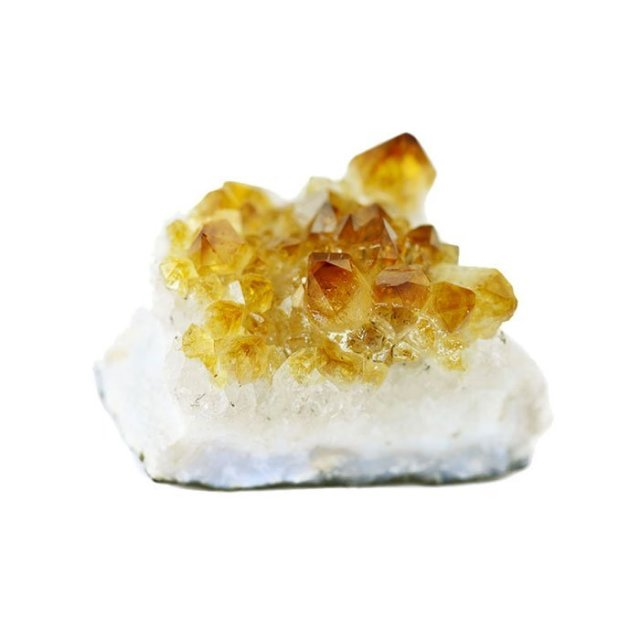
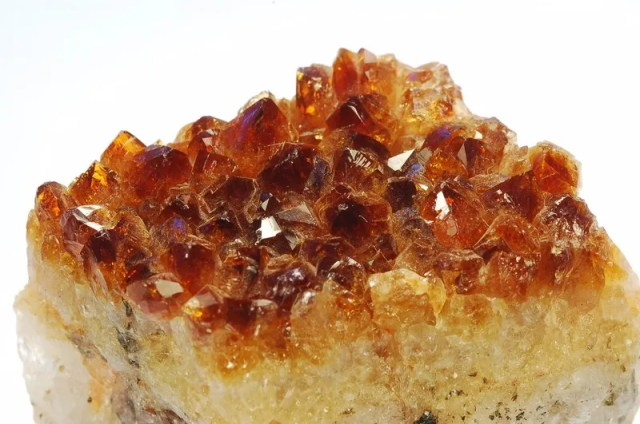
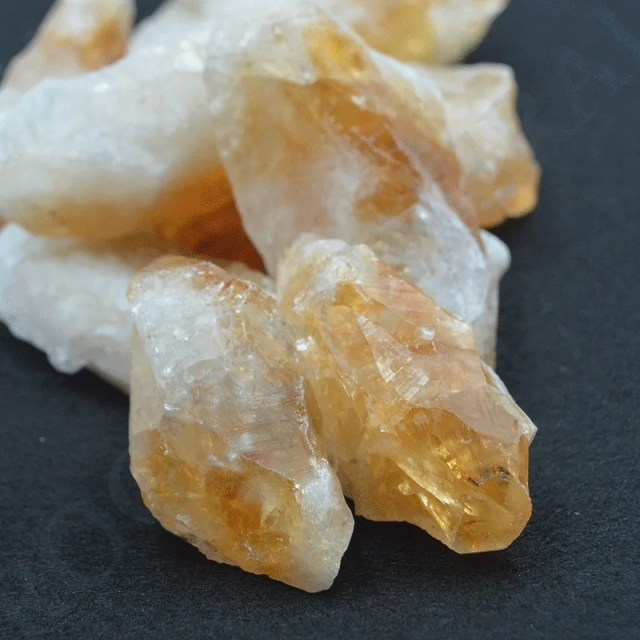
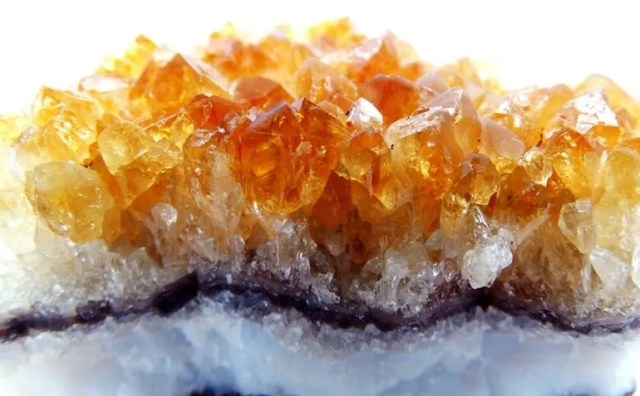
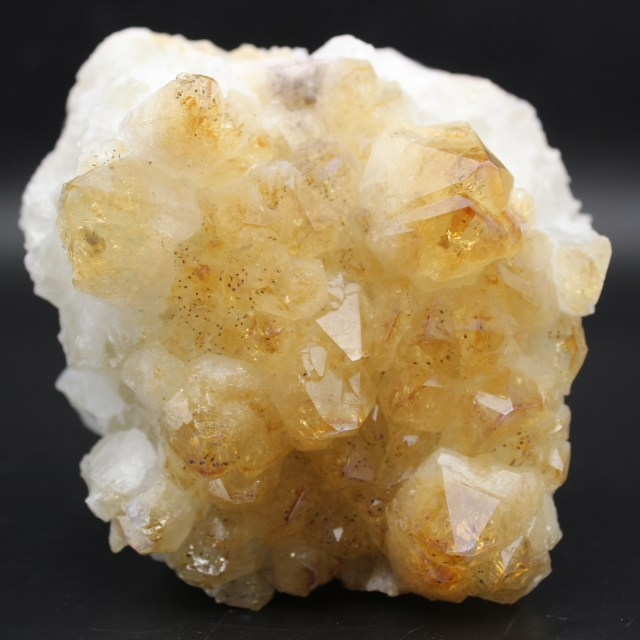
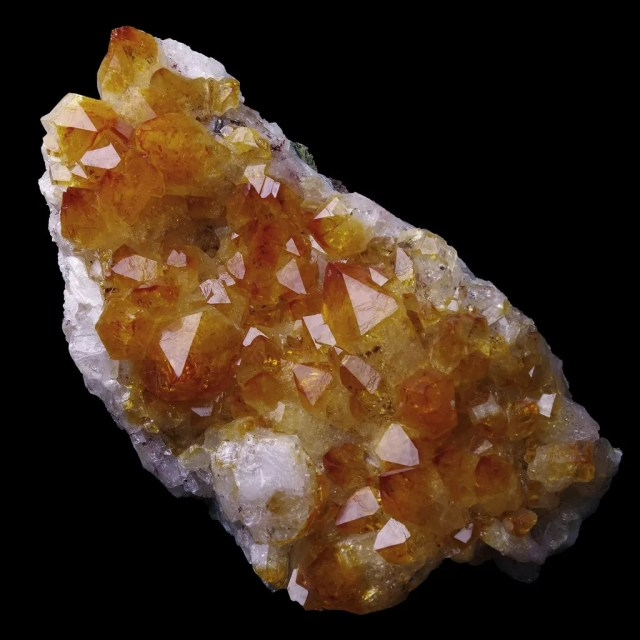
Geological settings where citrine is found
Citrine is found in a variety of geological settings, including:
- Hydrothermal veins: Citrine is often found in hydrothermal veins, which are veins of minerals that form when hot water circulates through rock fractures and precipitates minerals. Hydrothermal veins can occur in a variety of rock types, including granite, pegmatite, and gneiss.
- Volcanic rocks: Citrine can also be found in volcanic rocks such as rhyolite and andesite. These rocks form when magma rises to the surface and cools quickly, trapping minerals in the rock.
- Sedimentary rocks: Citrine can occur in sedimentary rocks such as sandstone and shale, where it is often found as a secondary mineral that formed from the alteration of other minerals.
- Alluvial deposits: Citrine can be found in alluvial deposits, which are deposits of sediment that have been transported and deposited by water. Alluvial deposits can occur in riverbeds, streambeds, and in the soil.
The most significant sources of citrine are Brazil, Madagascar, and Zambia. In Brazil, citrine is commonly found in hydrothermal veins in granite and pegmatite. In Madagascar, citrine is found in volcanic rocks and alluvial deposits. In Zambia, citrine is found in hydrothermal veins and alluvial deposits.
Formation and mineralogy of citrine
Citrine is a variety of quartz, which is a mineral composed of silicon and oxygen atoms arranged in a 3-dimensional structure. Citrine forms when amethyst or smoky quartz, two other varieties of quartz, are heated to high temperatures, usually around 470 degrees Celsius. The heating process changes the oxidation state of iron impurities within the crystal lattice, resulting in the yellow to brownish-yellow color of citrine.
The mineralogical composition of citrine is identical to that of other varieties of quartz, with the chemical formula SiO2. Citrine typically contains trace amounts of iron, which is responsible for the yellow to brownish-yellow coloration. The color of citrine can range from pale yellow to dark brownish-orange.
Citrine can also contain various inclusions, or microscopic particles, which can affect its appearance and value. Some common inclusions in citrine include mineral crystals, gas bubbles, and fluid-filled cavities.
In addition to natural citrine, there are also synthetic forms of citrine that are made using various methods, such as the hydrothermal method or the vapor deposition method. These synthetic forms of citrine have the same chemical composition and physical properties as natural citrine but are often less expensive due to their easier production process.
Physical properties of citrine
The physical properties of citrine are as follows:
- Hardness: Citrine has a hardness of 7 on the Mohs scale, which means it is relatively hard and durable.
- Color: Citrine is typically yellow to brownish-yellow in color, although it can also be found in shades of orange, reddish-brown, and smoky gray-brown.
- Transparency: Citrine is usually transparent to translucent.
- Luster: Citrine has a vitreous (glassy) luster, meaning it is shiny and reflective like glass.
- Specific gravity: The specific gravity of citrine is approximately 2.65 g/cm3, which is similar to other varieties of quartz.
- Refractive index: The refractive index of citrine is approximately 1.544-1.553, which is similar to other varieties of quartz.
- Cleavage: Citrine does not have a distinct cleavage, meaning it does not break along specific planes or directions.
- Fracture: Citrine has a conchoidal fracture, meaning it breaks with a curved, shell-like shape.
- Streak: The streak of citrine is white.
Overall, citrine is a relatively hard and durable mineral with a vitreous luster and a range of colors that make it popular for use in jewelry and decorative objects.
Chemical properties of citrine
The chemical composition of citrine is identical to that of other varieties of quartz, with the chemical formula SiO2. However, the yellow to brownish-yellow color of citrine is due to trace amounts of iron impurities within the crystal lattice. The amount of iron impurities present in citrine can vary, which can affect the color saturation and intensity of the stone.
In terms of chemical reactivity, citrine is relatively inert and does not react with most common acids or chemicals. However, it can be etched by hydrofluoric acid, which is a highly corrosive and dangerous chemical. Therefore, it is important to handle citrine with care and avoid exposure to strong acids or chemicals.
Citrine is also relatively resistant to heat, withstanding temperatures of up to 400-450 degrees Celsius without melting or decomposing. This makes it a suitable material for use in high-temperature applications, such as in furnace tubes and laboratory equipment.
Overall, the chemical properties of citrine are similar to those of other varieties of quartz, with the addition of iron impurities that give it its distinctive yellow to brownish-yellow color.
Color and clarity of citrine
The color of citrine can vary from pale yellow to deep amber, and is caused by the presence of trace amounts of iron in the crystal structure. The intensity and saturation of the color can vary depending on the concentration of iron, with darker, more intense colors indicating higher concentrations of the impurity.
Citrine is typically a transparent to translucent mineral, although it can also exhibit cloudy or milky areas, as well as inclusions and other internal features that can affect its clarity. Some citrine may also display a chatoyant effect, which is a narrow band of light that seems to move across the surface of the stone when it is viewed under certain lighting conditions.
In general, citrine that is transparent, free of inclusions, and has a rich, deep color is considered to be the most valuable and desirable. However, since citrine is a relatively abundant and readily available mineral, it is generally less expensive than other, rarer gemstones such as emeralds, rubies, and diamonds.
Comparison of natural and synthetic citrine
Natural citrine is formed by the gradual heating of amethyst, another variety of quartz, under high temperatures in the Earth’s crust. This process causes the iron impurities within the amethyst to change color from purple to yellow, resulting in the creation of natural citrine.
In contrast, synthetic citrine is typically created by heating a colorless variety of quartz, such as rock crystal, under high temperatures in the presence of certain chemicals or gases, which can cause the crystal to take on a yellow color.
There are a few key differences between natural and synthetic citrine that can be used to distinguish between the two:
- Color: Natural citrine has a range of yellow and brown hues, with variations in saturation and tone, while synthetic citrine tends to have a more uniform and artificial-looking yellow color.
- Inclusions: Natural citrine may contain some inclusions or imperfections, while synthetic citrine is usually free of inclusions.
- Price: Natural citrine is generally more expensive than synthetic citrine, since it is a rarer and more valuable gemstone.
- Origin: Natural citrine is mined from the Earth, while synthetic citrine is created in a laboratory.
While both natural and synthetic citrine can be used in jewelry and other decorative applications, some people prefer the unique character and natural beauty of natural citrine, while others may prefer the uniformity and affordability of synthetic citrine.

Geologic factors that influence the color and clarity of citrine
The color and clarity of citrine can be influenced by several geological factors, including the following:
- Iron content: The yellow color of citrine is caused by the presence of iron impurities within the crystal structure. The concentration and distribution of these impurities can affect the intensity, hue, and saturation of the color.
- Heat and pressure: Natural citrine is formed by the gradual heating of amethyst under high temperatures and pressures in the Earth’s crust. The specific conditions of the heating process can influence the color and clarity of the resulting citrine.
- Inclusions and other internal features: Citrine may contain inclusions or other internal features, such as cracks, bubbles, or cloudiness, that can affect its clarity and overall appearance.
- Geological environment: The geological environment in which citrine is formed can also influence its color and clarity. For example, citrine that forms in veins or pockets of quartz may have a different appearance than citrine that forms in geodes or other types of rock formations.
Overall, the combination of these geological factors can result in a wide range of colors and clarities for citrine, from pale yellow to deep amber, and from transparent to cloudy or milky. The most valuable and desirable citrine typically has a rich, deep color and high clarity, with minimal inclusions or other internal features.

Identification and classification of citrine based on its physical and chemical properties
The identification and classification of citrine is based on a combination of its physical and chemical properties. Some of the key characteristics that are used to distinguish citrine from other minerals and gemstones include the following:
- Color: Natural citrine typically has a yellow to golden-brown color, which is caused by the presence of iron impurities. Synthetic citrine, on the other hand, may be a variety of colors, including orange, pink, or green.
- Transparency: Citrine is generally transparent or translucent, with good to excellent clarity. Some specimens may contain inclusions or other internal features that can affect their transparency and overall appearance.
- Hardness: Citrine has a hardness of 7 on the Mohs scale, which means that it is relatively resistant to scratches and abrasions.
- Refractive index: Citrine has a refractive index of 1.544 to 1.553, which means that it bends light at a specific angle as it passes through the gemstone.
- Specific gravity: Citrine has a specific gravity of 2.65 to 2.91, which means that it is relatively heavy compared to other minerals and gemstones.
- Chemical composition: Citrine is a variety of quartz, which is composed of silicon dioxide (SiO2) with traces of other elements such as iron, aluminum, and titanium. The specific chemical composition of citrine can vary depending on its origin and geological environment.
Based on these properties, citrine is typically classified as a variety of quartz, and is sometimes referred to as “yellow quartz” or “golden quartz.” Within the gemstone industry, citrine may also be classified according to its color or clarity, with the most valuable specimens being those that exhibit a rich, deep yellow color and high clarity. Synthetic citrine may be classified separately from natural citrine, based on its chemical and physical properties.
Occurrence of citrine in different rock types
Citrine is typically found in association with igneous and metamorphic rocks. Some of the most common rock types where citrine may be found include:
- Granite: Citrine is often found in granite, which is a coarse-grained igneous rock that is composed of quartz, feldspar, and mica. Citrine crystals may form in veins or cavities within the granite, or may be present as inclusions or coatings on other minerals.
- Pegmatite: Pegmatites are a type of igneous rock that form from the cooling and crystallization of magma at a relatively slow rate. They are known for their large crystal sizes and complex mineral compositions, and are a common source of gemstones and minerals such as citrine.
- Gneiss: Gneiss is a metamorphic rock that forms from the transformation of pre-existing rocks under high heat and pressure. Citrine may be present in gneiss as a result of the recrystallization of quartz-rich sediments or rocks.
- Schist: Schist is another type of metamorphic rock that forms from the recrystallization of pre-existing rocks under high heat and pressure. Citrine may be present in schist as a result of the metamorphism of quartz-rich rocks or sediments.
- Hydrothermal veins: Citrine may also be found in hydrothermal veins, which are mineral deposits that form from hot, mineral-rich fluids that circulate through fractures and faults in the earth’s crust. These veins may be associated with a variety of rock types, including igneous, metamorphic, and sedimentary rocks.
Overall, citrine is relatively rare compared to other varieties of quartz, and is typically found in relatively small quantities within these different rock types. The specific geological environment where citrine is found can also have a significant impact on its quality, color, and overall value.
Distribution of citrine around the world
Citrine is found in many different locations around the world. Some of the most important sources of citrine include Brazil, Madagascar, Russia, Spain, Zambia, and the United States.
Brazil is the largest producer of citrine, and is known for producing some of the finest specimens of this gemstone. The state of Rio Grande do Sul in southern Brazil is particularly rich in citrine deposits, and is home to many famous mines and quarries. In fact, much of the citrine sold today is derived from Brazilian sources.
Madagascar is another important source of citrine, and is known for producing large, high-quality crystals in a range of colors. Citrine deposits are found in several regions throughout the country, including the Antananarivo Province and the Ilakaka region.
Russia is also an important producer of citrine, with deposits found in the Ural Mountains and other regions throughout the country. Russian citrine is often a pale yellow or smoky brown color, and is highly prized for its clarity and brilliance.
Other important sources of citrine include Spain, where deposits are found in the Catalonia region; Zambia, where deposits are found in the Luapula Province; and the United States, where citrine has been found in several locations throughout the country, including Colorado, North Carolina, and California.
Overall, citrine is a relatively common gemstone that is found in many different locations around the world. The quality and value of citrine can vary widely depending on the specific geological environment where it is found, as well as factors such as color, clarity, and size.
Geological techniques used in the exploration and extraction of citrine
The exploration and extraction of citrine typically involves a range of geological techniques and processes. Here are some of the most common:
- Prospecting: The first step in exploring for citrine is to locate areas where it is likely to be found. This involves studying geological maps and conducting field surveys to identify regions with the right geological conditions.
- Mining: Once a deposit of citrine has been identified, the next step is to extract the gemstone from the surrounding rock. This is typically done using a combination of open-pit and underground mining methods, depending on the specific geological environment.
- Sorting: After the citrine has been extracted, it must be sorted and graded according to quality. This is typically done by hand, with workers examining each gemstone and sorting them according to factors such as color, clarity, and size.
- Cutting and polishing: Once the citrine has been sorted and graded, it is ready to be cut and polished into finished gemstones. This is typically done using specialized equipment and techniques, with skilled craftspeople working to bring out the natural beauty and brilliance of the gemstone.
- Gemological analysis: To fully understand the properties and characteristics of citrine, it is often subjected to gemological analysis using a range of techniques, such as spectroscopy, X-ray diffraction, and refractometry. This can help to identify impurities and other features that may affect the quality and value of the gemstone.
Overall, the exploration and extraction of citrine involves a range of geological techniques and processes, from prospecting and mining to sorting, cutting, and polishing. By using these techniques effectively, it is possible to extract high-quality citrine gemstones that are valued for their beauty and rarity.-
Uses
Citrine has been valued as a gemstone for thousands of years, and is still highly prized today for its beauty and rarity. Some of the most common uses of citrine include:
- Jewelry: Citrine is widely used in jewelry, both as a standalone gemstone and in combination with other gems. It is often used in rings, necklaces, bracelets, and earrings, and is especially popular for its warm, golden color.
- Decorative objects: Citrine is also used in a variety of decorative objects, such as vases, sculptures, and figurines. Its bright, sunny color makes it a popular choice for these types of objects, and it is often used in combination with other gemstones and materials.
- Healing and spiritual practices: Citrine is sometimes used in healing and spiritual practices, where it is believed to have a range of positive effects on the body and mind. For example, it is often used to promote clarity of thought, enhance creativity, and boost energy levels.
- Industrial applications: In addition to its use as a gemstone, citrine also has a range of industrial applications. It is sometimes used as a heat-resistant material in furnace linings and other high-temperature applications, and can also be used as a source of silicon in the production of solar panels.
Overall, citrine is valued for its beauty, rarity, and versatility, and is used in a wide range of applications, from jewelry and decorative objects to healing practices and industrial applications.
Summary of key points
- Citrine is a yellow to golden brown colored gemstone that is a type of quartz.
- It is found in a variety of geological settings around the world, including igneous rocks, hydrothermal veins, and sedimentary deposits.
- The color of citrine is influenced by a variety of geological factors, including the presence of iron impurities, heat, and radiation.
- Citrine has a range of physical and chemical properties, including a hardness of 7 on the Mohs scale, a density of 2.65 g/cm3, and a chemical composition of SiO2.
- Natural citrine is rare, and most of the citrine on the market is heat-treated amethyst or smoky quartz.
- Citrine is widely used in jewelry, decorative objects, healing and spiritual practices, and industrial applications.
- Citrine is valued for its beauty, rarity, and versatility, and is a popular gemstone among collectors, jewelry designers, and consumers.
FAQ
What is citrine?
Citrine is a yellow to golden brown colored gemstone that is a type of quartz.
How is citrine formed?
Citrine is formed through a combination of geological processes, including the hydrothermal deposition of silica-rich fluids and the exposure of quartz to natural radiation and heat.
Where is citrine found?
Citrine is found in a variety of geological settings around the world, including igneous rocks, hydrothermal veins, and sedimentary deposits.
What gives citrine its color?
The color of citrine is influenced by a variety of geological factors, including the presence of iron impurities, heat, and radiation.
Is natural citrine rare?
Yes, natural citrine is rare, and most of the citrine on the market is heat-treated amethyst or smoky quartz.
What are the physical and chemical properties of citrine?
Citrine has a range of physical and chemical properties, including a hardness of 7 on the Mohs scale, a density of 2.65 g/cm3, and a chemical composition of SiO2.
What are the uses of citrine?
Citrine is widely used in jewelry, decorative objects, healing and spiritual practices, and industrial applications.
Is citrine valuable? Citrine is valued for its beauty, rarity, and versatility, and is a popular gemstone among collectors, jewelry designers, and consumers.
Can citrine be synthetic?
Yes, synthetic citrine can be produced through a variety of methods, including hydrothermal synthesis and the deposition of thin films on substrates.
Is citrine associated with any spiritual or healing properties?
Citrine is believed to have a range of spiritual and healing properties, including enhancing creativity, boosting self-confidence, and promoting abundance and prosperity.
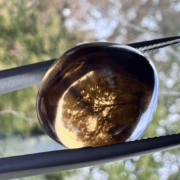
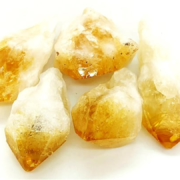
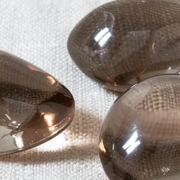
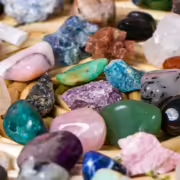
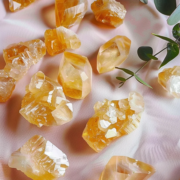
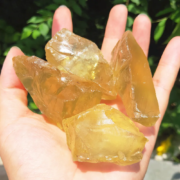


Leave a Reply
Want to join the discussion?Feel free to contribute!